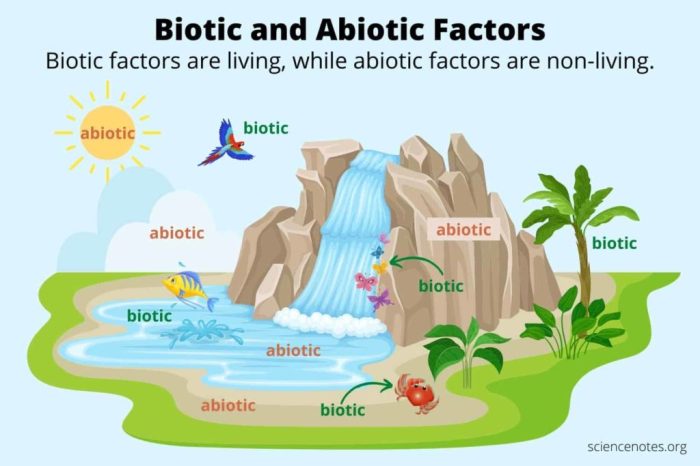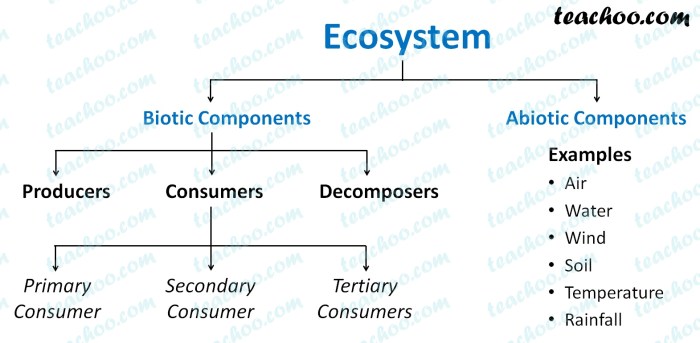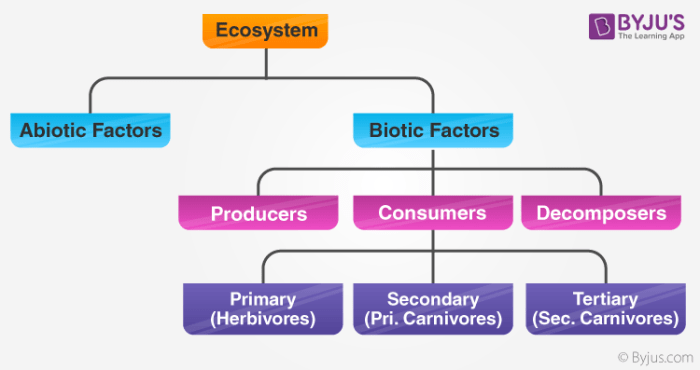Abiotic components of an ecosystem include quizlet takes center stage, this opening passage beckons readers into a world crafted with authoritative knowledge, ensuring a reading experience that is both absorbing and distinctly original. Delving into the intricacies of these non-living elements, we unravel their profound influence on the distribution, abundance, and dynamics of life within ecosystems.
Abiotic components, encompassing elements such as sunlight, water, temperature, and soil, form the physical and chemical foundation upon which ecosystems thrive. Their characteristics and interactions shape the ecological landscape, influencing the distribution and abundance of organisms, regulating ecosystem processes, and driving ecosystem dynamics.
Abiotic Components of an Ecosystem: Abiotic Components Of An Ecosystem Include Quizlet

Abiotic components are non-living elements of an ecosystem that influence the survival, distribution, and abundance of living organisms. They include physical and chemical factors that shape the environment in which organisms live.
The abiotic components of an ecosystem can be categorized into several types, including:
- Climatic factors: temperature, precipitation, sunlight, wind, and humidity
- Edaphic factors: soil type, soil pH, soil moisture, and soil nutrients
- Geologic factors: rock type, topography, and elevation
- Hydrologic factors: water availability, water quality, and water flow
- Atmospheric factors: air temperature, air pressure, and air composition
Role of Abiotic Components in Ecosystem Functioning, Abiotic components of an ecosystem include quizlet
Abiotic components play a crucial role in regulating ecosystem processes and determining the distribution and abundance of organisms. They influence:
- Organism distribution: Abiotic factors determine the suitability of an environment for different species. For example, temperature and precipitation influence the geographic distribution of plants and animals.
- Ecosystem processes: Abiotic factors regulate nutrient cycling, energy flow, and other ecosystem processes. For example, soil moisture affects the decomposition of organic matter and the availability of nutrients to plants.
Abiotic Components and Ecosystem Dynamics
Abiotic components are not static but can change over time. These changes can impact ecosystem structure and dynamics.
For example, changes in climate can lead to shifts in species distribution and abundance. Similarly, changes in soil pH can affect the availability of nutrients and alter plant communities.
Interactions between Biotic and Abiotic Components
Biotic and abiotic components are closely intertwined and influence each other. Organisms can modify their abiotic environment through their activities, such as:
- Plants release oxygen and water vapor into the atmosphere, influencing air composition and humidity.
- Animals create and maintain habitats by building nests or burrows, altering the soil structure and microclimate.
Conversely, abiotic factors can also influence the behavior and physiology of organisms. For example, temperature affects the metabolic rate and activity patterns of animals.
Abiotic Components and Ecosystem Services
Abiotic components contribute to the provision of ecosystem services that benefit human well-being. These services include:
- Air purification: Plants and water bodies remove pollutants from the air.
- Water regulation: Wetlands and forests regulate water flow, reducing flooding and droughts.
- Soil formation: Rocks and minerals break down to form soil, which supports plant growth and provides habitat for organisms.
Maintaining healthy abiotic conditions is crucial for sustaining ecosystem services and human well-being.
Questions and Answers
What are abiotic components of an ecosystem?
Abiotic components are non-living physical and chemical factors that shape the environment of an ecosystem, including sunlight, water, temperature, soil, and atmospheric gases.
How do abiotic components influence ecosystem functioning?
Abiotic components regulate ecosystem processes such as nutrient cycling, energy flow, and the distribution and abundance of organisms.
What is the significance of abiotic components in ecosystem dynamics?
Abiotic components drive ecosystem dynamics by influencing the structure and composition of ecological communities and mediating ecological processes over time.

